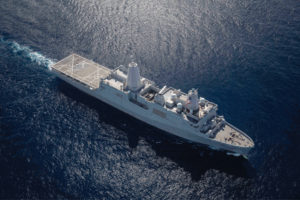RSL Projects

From Idea to Function: Lighting the LPD Ship Class
The scenario:
In the late 1990s Ingalls Shipbuilding, a division of Northrop Grumman, was designing the new LPD ship class to include composite mast structures which would reduce the radar cross section (RCS). This vessel design required navigation and signaling lights in places where maintenance could not be done, and Ingalls was looking for a solution for these, essentially, inaccessible lights.
The problem:
Another division of Northrop Grumman, Winchester Electronics, had previously piloted the concept of a remote source lighting system on the DDG 78 USS Porter. The concept of remote source lighting was attractive for vessels with difficult or dangerous areas to reach for required maintenance as it housed the light source (light engine) in an accessible place while the light illuminated elsewhere on the ship. Unfortunately, the early Winchester prototype was not able to meet light intensity requirements and had insufficient reliability for Navy use. So, Ingalls needed a partner who could implement not only a functional, reliable remote source lighting system, but maintain the light’s integrity and precision for high stakes use.
The solution:
The short story is, RSL became a pioneer in remote source lighting technology by leveraging our expertise in light distribution, fiber optic cables, and attention to practical use. The more complete telling of this technology innovation is a two-part development journey.
Phase One: Synthesizing theoretical application with cutting edge technology
RSL became the system integrator for a multidisciplinary ManTech (Manufacturing Technology Improvement) team assembled by Ingalls Shipbuilding and funded by the U.S. Navy Office of Naval Research. We assessed lessons from Winchester Electronics’ pilot and designed a baseline for remote source lighting systems compatible utilizing a new glass fiber cable capable of producing light intensities that met the navigation light requirements.
Phase Two: Design for Real Application
RSL then contracted for and designed a fully functional and compliant remote source lighting system for the LPD ship class. We faced myriad challenges in this process of theory to application, including heat management of high-intensity gas discharge lamps, light energy coupling onto smaller glass fiber cable, building units which pass demanding mechanical and environmental testing requirements (shock, vibration, temperature cycling), and designing all hardware required to install and maintain this new technology.
That technology today:
After the first deployment of the LPD class’s first ship, the LPD 17 USS San Antonio, Commanding Officer CDR Lee was so impressed by the performance of the RSL lights that he urgently requested additional lights be upgraded to the RSL configuration on his and future ships in the class.
To date, thirteen LPD ships are in service with the RSL lights, two are under construction, and eleven more are planned.

